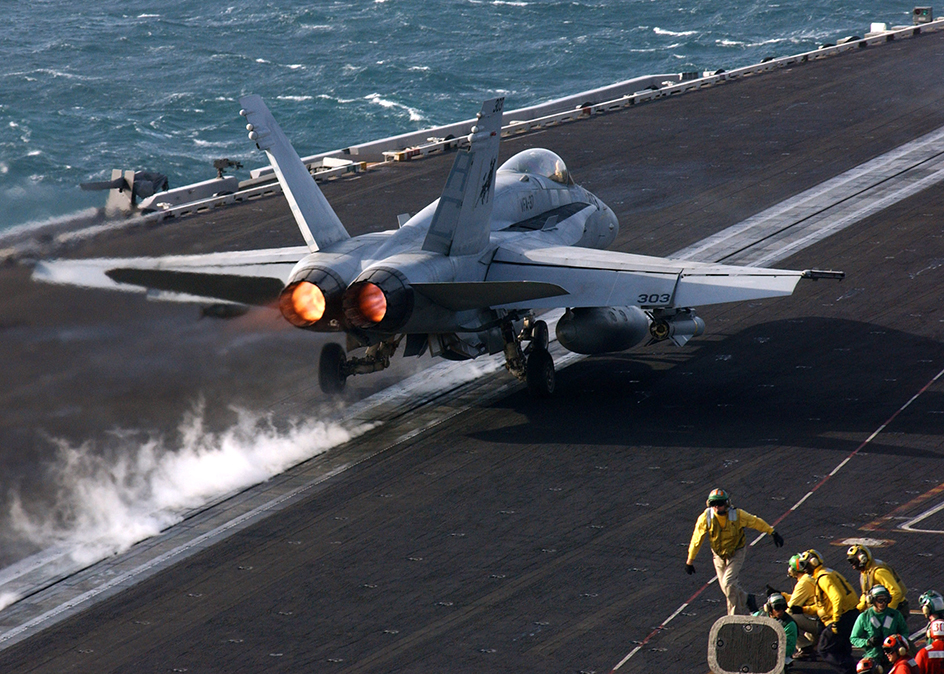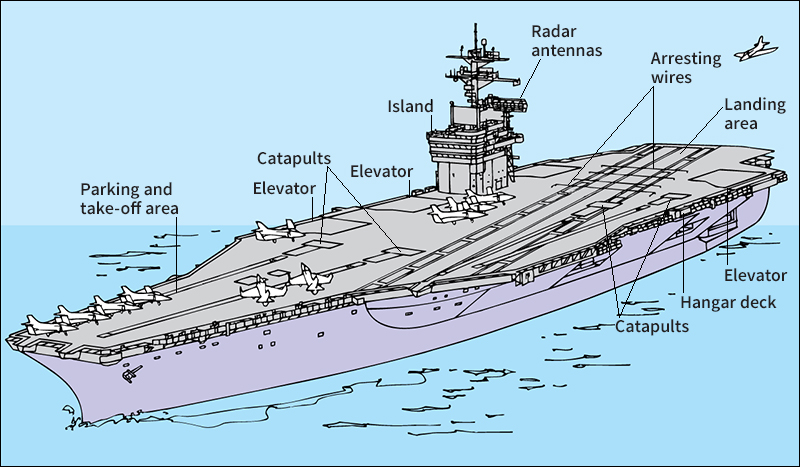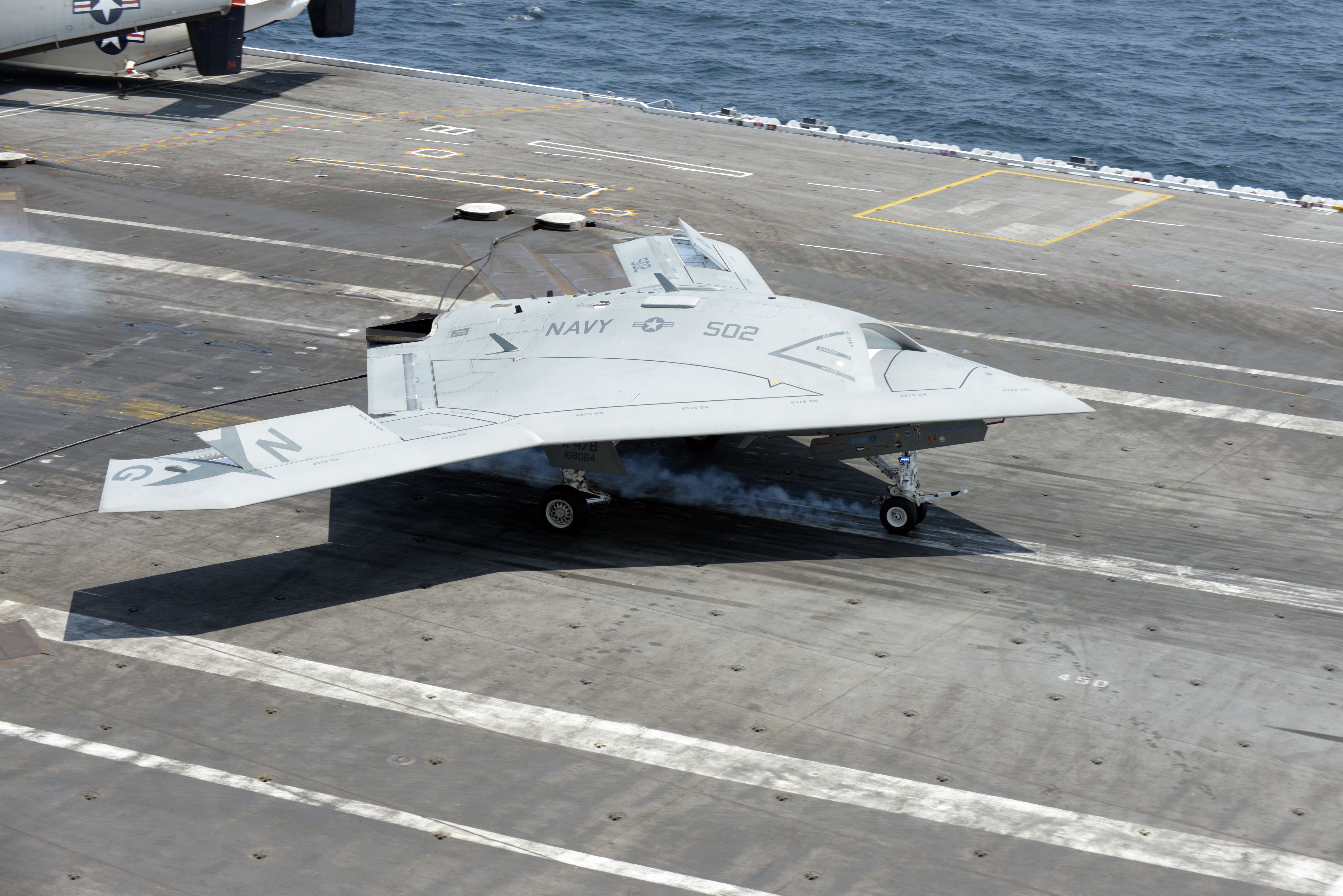Aircraft carrier is a ship used as a mobile base for airplanes. With its aircraft striking force, the carrier is the most powerful surface warship. Carriers are often called flattops because of their wide, flat decks. The only ships bigger than carriers are the largest oil tankers.

Aircraft carriers are equipped with only a minimum number of antiaircraft guns or defensive missiles. Carriers usually steam (travel) with other ships. Cruisers, destroyers, and submarines protect aircraft carriers from enemy missiles, planes, surface ships, and submarines. Such a fleet is called a carrier task force or battle group.
Airplanes take off from and land on the flight deck. They are repaired and stored on the hangar deck just below it. Large elevators move the planes from one deck to the other. The superstructure of the ship, called the island, includes the command and navigation bridges, communications equipment, radar antennas, and smokestacks, unless the ship has nuclear power. The island rises on the flight deck’s starboard side (right side facing forward). The rest of the deck is left clear for planes. A carrier also houses maintenance shops for the planes and living quarters and mess (cooking and eating areas) for the pilots, air crews, and ship’s crew. It has storage space for bombs, ammunition, fuel, and food.
The United States Navy operates the world’s largest carrier fleet, consisting of 11 major ships. The navies of Brazil, China, France, India, Russia, and the United Kingdom also have carriers that launch and land conventional aircraft. The U.S. Navy also operates 9 amphibious assault ships, which resemble small aircraft carriers. Helicopters and V/STOL (_V_ertical/_S_hort _T_ake-_O_ff and _L_anding) aircraft operate from these ships. The navies of several countries, including Australia, Italy, Japan, South Korea, Spain, and Thailand include at least one of these small carriers.

Flight operations.
Conventional airplanes are too heavy and require too great an airspeed to take off from a carrier entirely under their own power. For this reason, they are launched by a catapult from the take-off areas (see Catapult ). The carrier steams into the wind at high speed during take-offs. Wind speed plus the ship’s speed helps lift the planes as they take off.
The carrier also heads into the wind when planes land. If a carrier steams at 25 knots (nautical miles per hour) into a wind blowing 25 knots, then the wind speed over the carrier’s deck is 50 knots. A plane flying at 100 knots thus has a relative landing speed of only 50 knots. Arresting gear, four steel cables stretched across the rear landing area of the deck, catch a tail hook lowered from the plane. The plane is brought to a stop over a distance of about 300 feet (91 meters).
Modern carriers for conventional aircraft have angled landing sections on their flight decks. The landing section, which takes up the rear two-thirds of the deck, angles toward the carrier’s port side (left side facing forward) and extends over the water. A plane that makes a bad approach or misses the arresting wires with its tail hook may keep going and fly off the deck. Helicopters and certain other aircraft can take off and land vertically and so require no runway.
The United States carrier fleet.
Aircraft carriers are the U.S. Navy’s principal warships. They carry jet fighters and jet bombers. They also have radar, reconnaissance, and tanker planes, and antisubmarine aircraft. Each carrier usually carries six helicopters.
The Navy groups its carriers by class. The name of each class is the name of the first ship built in that class. Most active carriers today are Nimitz class. These 10 nuclear-powered ships are the Nimitz, the Dwight D. Eisenhower, the Carl Vinson, the Theodore Roosevelt, the Abraham Lincoln, the George Washington, the John C. Stennis, the Harry S. Truman, the Ronald Reagan, and the George H. W. Bush.
Nimitz-class ships are among the world’s largest warships measured in displacement tonnage. This measurement refers to the number of long tons or metric tons of water displaced (pushed aside) by a ship. Each Nimitz-class ship displaces 97,000 long tons (98,600 metric tons) when fully loaded. Each ship is 1,092 feet (333 meters) long and has a flight deck 252 feet (77 meters) wide. Each can carry 85 aircraft and about 5,700 people.

The Gerald R. Ford, a nuclear-powered carrier with a new design, was commissioned in 2017. It is the first of the Ford class of carriers built to replace older Nimitz-class ships. The Gerald R. Ford displaces about 100,000 long tons (102,000 metric tons).
The only aircraft that the Navy’s nine amphibious assault ships can deploy are V/STOL aircraft and helicopters. These ships are not nuclear-powered and are designed primarily for use in attacking targets on land. The Navy does not classify them as aircraft carriers, though they have capabilities similar to those of small carriers operated by other countries.
History.
Beginning in 1910, British and American pilots experimented with take-offs and landings from ships. In 1917, the Furious, a British Royal Navy cruiser, was outfitted with a flight deck. The first ship to have a full, unobstructed flight deck was the Royal Navy’s Argus, completed in 1918. The first aircraft carrier in the United States Navy was the Langley, a converted collier (coal ship). It went into service in 1922. The Ranger, commissioned by the U.S. Navy in 1934, was the first ship built especially for aircraft.

During World War II (1939-1945), the warring nations built more than 150 aircraft carriers. They were the most important ships of the war. Planes launched from Japanese carriers attacked the U.S. naval base at Pearl Harbor, Hawaii, and the first United States air raid on Japan was made by bombers from the Hornet. British aircraft carriers escorted supply convoys in the Atlantic Ocean and the Mediterranean Sea, and also took part in fleet actions such as the sinking of the German battleship Bismarck.
After the war, many carriers were scrapped. By the 1960’s, only the United States maintained a large fleet of carriers. Among these ships were those of the Forrestal class—the Forrestal, the Saratoga, the Ranger, and the Independence. The Forrestal, commissioned in 1955, was the first U.S. carrier to have an angled flight deck and to carry jet fighters. Forrestal-class ships carried more aircraft than previous carriers, and they were sometimes called supercarriers.
The Kitty Hawk, the first of the Kitty Hawk class of U.S. supercarriers, was commissioned in 1961. Other ships of the class were the America and the Constellation. A fourth ship, the John F. Kennedy, was similar in design to the ships of the Kitty Hawk class. In 1961, the U.S. Navy commissioned the Enterprise, the first nuclear-powered aircraft carrier in history. It was the only ship of its Enterprise class.
